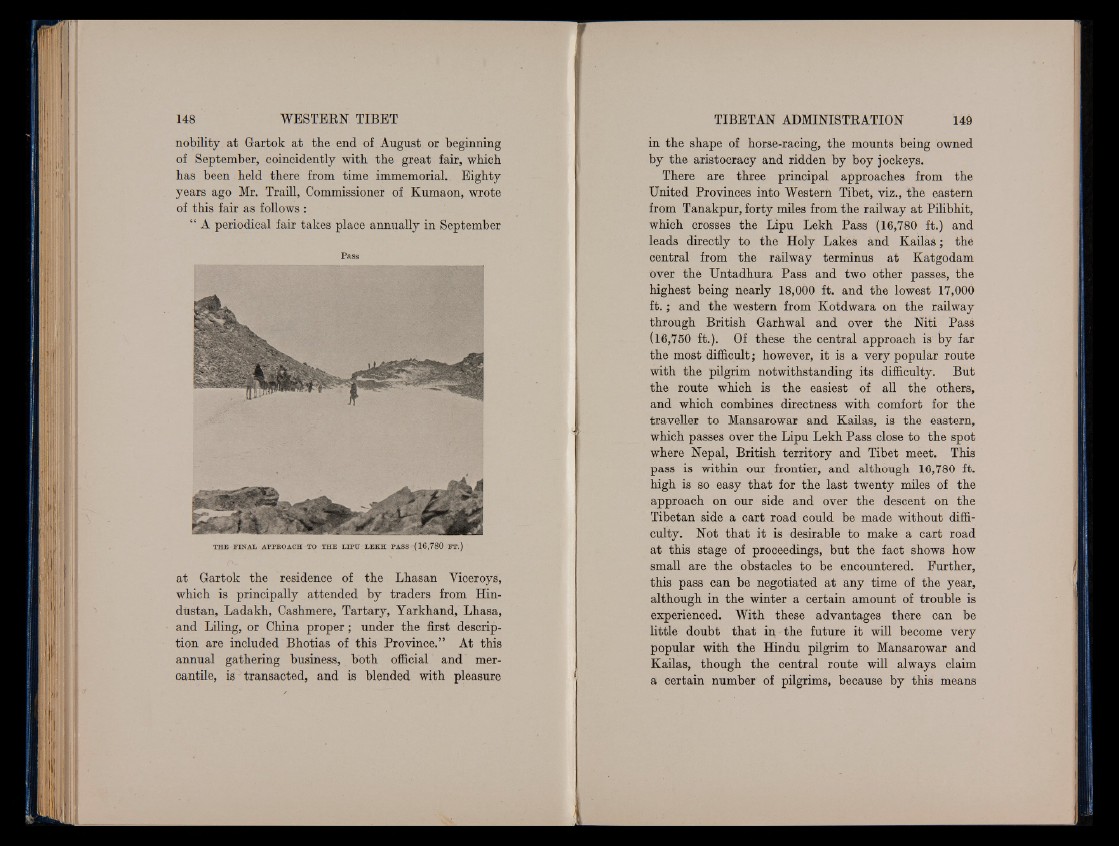
nobility at Gartok at the end of August or beginning
of September, coincidently with the great fair, which
has been held there from time immemorial. Eighty
years ago Mr. Traill, Commissioner of Kumaon, wrote
of this fair as follows :
“ A periodical fair takes place annually in September
THE FINAL APPBOACH TO THE LIPU LEEH PASS (16,780 FT.)
at Gartok the residence of the Lhasan Viceroys,
which is principally attended by traders from Hindustan,
Ladakh, Cashmere, Tartary, Yarkhand, Lhasa,
and Liling, or China proper ; under the first description
are included Bhotias of this Province.” At this
annual gathering business, both official and mercantile,
is transacted, and is blended with pleasure
in the shape of horse-racing, the mounts being owned
by the aristocracy and ridden by boy jockeys.
There are three principal approaches from the
United Provinces into Western Tibet, viz., the eastern
from Tanakpur, forty miles from the railway at Pilibhit,
which crosses the Lipu Lekh Pass (16,780 ft.) and
leads directly to the Holy Lakes and Kailas; the
central from the railway terminus at Katgodam
over the Untadhura Pass and two other passes, the
highest being nearly 18,000 ft. and the lowest 17,000
f t . ; and the western from Kotdwara on the railway
through British Garhwal and over the Niti Pass
(16,750 ft.). Of these the central approach is by far
the most difficult; however, it is a very popular route
with the pilgrim notwithstanding its difficulty. But
the route which is the easiest of all the others,
and which combines directness with comfort for the
traveller to Mansarowar and Kailas, is the eastern,
which passes over the Lipu Lekh Pass close to the spot
where Nepal, British territory and Tibet meet. This
pass is within our frontier, and although 16,780 ft.
high is so easy that for the last twenty miles of the
approach on our side and over the descent on the
Tibetan side a cart road could be made without difficulty.
Not that it is desirable to make a cart road
at this stage of proceedings, but the fact shows how
small are the obstacles to be encountered. Further,
this pass can be negotiated at any time of the year,
although in the winter a certain amount of trouble is
experienced. With these advantages there can be
little doubt that in the future it will become very
popular with the Hindu pilgrim to Mansarowar and
Kailas, though the central route will always claim
a certain number of pilgrims, because by this means